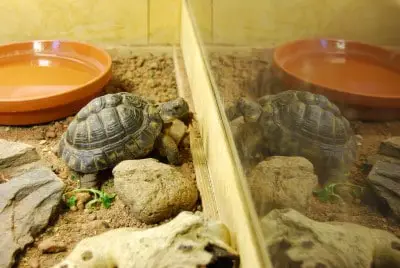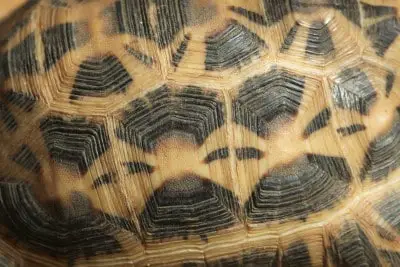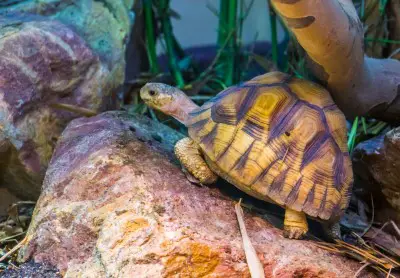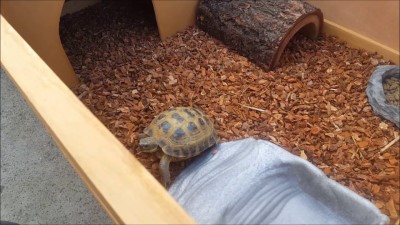Reptiles can cry, just like humans. The difference is, when humans do it, it shows strong emotions such as pain or sadness. If you have noticed your turtle or tortoise crying and are worried that something is wrong, you will be surprised to know that it is a common occurrence.
Tortoises may cry as a natural way of cleaning their eyes. It may also happen if its environment is not conducive or it has a respiratory infection. If it is too dusty or windy, they get teary to get rid of the dust from their eyes. Also, it may be due to a problem with their eyes, such as an infection or injury.
By closely studying a tortoise’s behavior, you will notice that they cry often. We made it our mission to find out why and give you all the logical explanations. Read on as we tell you why you don’t need to worry about your little friend’s cries.

Is It Normal for Tortoises To Cry?
Many pet owners would be alarmed at first to find their pet teary-eyed. One tortoise is famous for its tears, the Sulcata Tortoise, also known as “the Crying Tortoise.” Most pet tortoises have dark eyes, except box tortoises, whose eyes are brightly colored to match their head’s color streaks. Despite their excellent vision, their retinas don’t possess blood vessels.
It is normal for most turtles and tortoises to cry, and you need not worry. Unlike the human eye, they lack tear ducts to deliver tears down their noses. Hence, when they cry, it leaks down along the face. When they don’t do it often, there is no need to worry. It is natural to notice your turtle crying or with teary eyes.
You would worry that they do it because they are sad or in pain; only humans cry to portray sentiments. Reptiles do not have emotions as you do. Therefore, it is improbable that they would do it because of their feelings. They don’t form emotional connections with each other or with their owners, neither do they cry when they get hurt. Their eyes voluntarily excrete salty tears that leak down from the sides of their faces. When this happens, you can wipe the tears away using a clean cloth or cotton wool.
Although teary eyes are natural and common in reptiles, especially turtles and tortoises, there are exceptions. If you notice frequent crying or any abnormalities, it may be best to contact a vet for advice. Alarming signs include puffiness, reddening, eyes closed most of the time, and difficulty in eating. Also, your pet may have an eye infection, eye injury, or a respiratory problem.
Why Do Tortoises Cry?
Humans associate crying with unpleasant feelings. Thus, new tortoise owners would be alarmed to see their pets shedding tears or with bubbly eyes.
Crying for tortoises is essential in creating a salt balance in their bodies. Your tortoise may also cry if its eyes are too dry. When in the wild, these reptiles live in dry and windy climates; hence, it is common to find their eyes dry due to dehydration. Dry eyes cause the tortoise a lot of stress, and, as a result, their body has to come up with a means of lubrication. With the release of tears, the eyes can be wet again.
Comparing the tortoise to the turtle, the turtle cries more often. Since the turtles live in salty seawater, their drinking water is excessively salted. Their bodies have to get rid of these high salt levels to create a balance in their systems. They eliminate this salt that comes out as tears through a salt gland in their eyes.
Crying is an innate behavior most tortoises have adopted as protection from the harsh climatic conditions. Unless it is well-hydrated, you will notice liquid leaking from its eyes. Similarly, the crying may be a sign that the humidity level in the tank is unfavorable. Therefore, your reptile may have watery eyes because the substrate is too dry.
Given that tortoises spend most of their time on land, they are susceptible to dust and foreign particles in the air. Sometimes, these materials get into their eyes, especially when it is windy. As a protective measure, their eyes get teary to expel these particles from their eyes. Hence, if there is a lot of dust, you will notice your tortoise crying.
Another reason why your tortoise has tears in its eyes may be due to an eye injury. They may flow when they have an eye problem. Some experts advise that you can use eye drops to help. If the condition doesn’t change, you can contact a vet for the way forward.
Interestingly, when turtles and tortoises cry, you may notice butterflies roaming around them. As it turns out, crying is not only beneficial to the reptiles; butterflies, too, have a lot to gain from it. They are attracted to these tears because they contain high levels of sodium. This nutrient is vital to the butterflies; thus, you will find them hovering around trying to ingest them. Their presence shouldn’t worry you since they do not harm the tortoises in any way.
Read more: How Smart Are Turtles and Tortoises
How To Stop Your Tortoise From Crying
Three main reasons cause your tortoise to cry. It may be a normal biological reaction to balance its body’s salt levels. Secondly, the eyes may water if the conditions are not favorable; let’s say there are too many dust particles in the air. Lastly, it may be due to an infection. As soon as you establish why your tortoise is frequently crying, you will know how best to deal with it.
If the issue is due to high salt levels in the water they drink, you can help control it. Whenever you give them food or drinking water, ensure that it is clean and fresh; this way, they will not ingest excess salt. Since they get teary to balance the body’s salt levels, they won’t need to cry if the water you provide is pure.
Secondly, you can help your pet by providing a suitable environment. Having your tortoise in the tank for a significant part of the day will shield them from harsh weather conditions such as excess wind. It would help if you hid them from dust and strong wind that irritates their eyes. If you have to take them outside, ensure that the weather is calm and the place is not too dusty.
It may also be helpful to check their enclosure’s humidity levels. Perhaps their substrate is too dry, making the air in the tank dry as well. It would help to regularly spray down their bedding with water to make it moist enough.
However, be careful not to make the substrate soaking wet; the aim is to prevent it from drying, not make it damp and sticky. Some owners may go further to provide them with some water to dip in whenever they feel hot. Alternatively, you can personally bathe them at least twice a day. Doing so may help prevent dryness in their eyes and hydrate them. It is also advisable to occasionally spray them with water to minimize dehydration.
Lastly, if the tearing is frequent and something is different about their eyes, it is best to ask a vet for guidance. In case the tortoise has an eye infection, the eyes will appear red and swollen. Similarly, if it often has its eyes closed; the tears will then be an aftermath of a severe eye condition. It may also be a sign that your pet is suffering from a respiratory problem. Avoid exposing your pet to the cold to prevent chances of contracting respiratory infections. Moreover, if your pet recently hibernated, it is likely to acquire problems with respiration.
To be sure, you can check for any differences in their usual demeanor. One sure way to observe changes is if your pet has appetite loss. Always trust your gut when you feel that something is wrong. The faster and sooner you visit the doctor, the higher the chances of your pet recovering from whatever is ailing it. Your doctor may prescribe some antibiotics or other medications to help.
Tortoises Do Cry
There are many reasons why your tortoise is frequently teary-eyed. First, it may be a normal watery secretion from the eyes. Due to lack of tear ducts, the tears flow down their faces. If their environment is too dry or they get severely dehydrated, they will get teary. These reasons are common and easy to control. By providing a conducive environment, you will notice a significant change.
On the contrary, there are other problematic reasons for the crying. It may be a respiratory infection or an eye injury. Therefore, it would be best not to ignore it when it becomes persistent. You can contact a vet for professional assistance if you feel something is wrong with your tortoise.
Read more:








